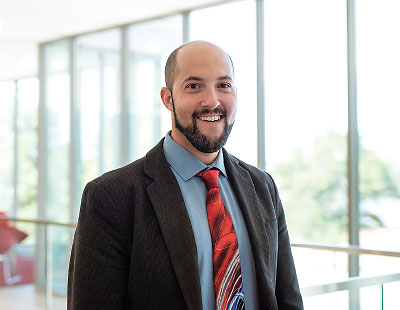Integrated Behavioral Approaches Show Promise in Treating Pain
Abstract
By integrating elements of mindfulness and positive psychology, researchers have found new options to provide relief to patients without pharmacology.
Drug overdose deaths reached historic levels in 2021, driven predominantly by opioid overdose deaths, according to data from the Centers for Disease Control and Prevention. As the opioid crisis rages on, more people are searching for effective, medication-free approaches to pain management.
Because pain is not just a physical experience but also emotional, some have turned to mindfulness techniques, which build emotional health through tools including meditation, yoga, and self-awareness.

One of the key goals of Mindfulness-Oriented Recovery Enhancement (MORE) is to restore people’s pleasure from healthy, natural rewards, says program developer Eric Garland, Ph.D.
Mindfulness-Oriented Recovery Enhancement (MORE) is one such intervention. The program integrates mindfulness meditation, cognitive-behavioral therapy, and positive psychology techniques. It was developed a decade ago by Eric Garland, Ph.D., the associate dean for research at the College of Social Work at the University of Utah and director of the university’s Center on Mindfulness and Integrative Health Intervention Development.
“While training for my doctorate [with Barbara Fredrickson, Ph.D., a leader in the field of positive psychology], I was steeping myself in the neuroscience of addiction and learned how one of the key drivers of substance use was hedonic dysregulation—people become insensitive to pleasure from healthy rewards and thus need more and more of a drug to feel good,” Garland told Psychiatric News. With further study, Garland found that hedonic dysregulation was a common deficit not only for people experiencing addiction but also those experiencing chronic pain and depression.
Garland’s work with Fredrickson led him to look for ways to incorporate savoring—which teaches patients how to focus on pleasurable events and sensations—into mindfulness therapy. To reinforce the focus on pleasure, he incorporated reappraisal techniques—a component of cognitive-behavioral therapy (CBT) that aims to reframe people’s maladaptive thoughts and reduce negative emotions—into the program. The final result was MORE, a group therapy delivered in two-hour sessions over eight weeks.
Preliminary studies found that MORE, by itself or as an adjunct to methadone, was effective in treating people with chronic pain and opioid misuse.
Garland’s most recent trial involved 250 adults (average age: 51 years) with chronic pain who were also misusing opioids. The participants were randomly assigned to eight sessions of either MORE or supportive group psychotherapy (sessions that included discussions about such topics as coping with pain, managing negative emotions, and the adverse effects of opioids). Both interventions were delivered by the same set of clinical social workers over a two-month period.
Garland noted that the adults who participated had significant problems: They had been experiencing pain for an average of nearly 15 years, 76% reported multiple pain-related conditions, 68% met the criteria for major depression, and 63% met the criteria for opioid use disorder. Despite these challenges, participants in the MORE group showed improvements on a variety of outcomes, according to a report in JAMA Internal Medicine.
Nine months after treatment finished, 45% of the participants who received MORE group therapy were no longer misusing opioids compared with 24% of those who received supportive group psychotherapy. Participants who received MORE also reported less severe pain symptoms, less pain interference (how much pain interferes with their daily lives), fewer opioid cravings, and fewer depressive symptoms than those in the supportive psychotherapy group.
Garland noted that since MORE has been tested against an active treatment where participants also received social support and therapist guidance, the benefits of MORE are not a placebo effect. “This intervention works,” he said. He is hoping to next test MORE head to head against CBT, the gold-standard treatment for pain and addiction.
Short Education Session Also Works
“Garland’s work has contributed greatly to our understanding of how to treat people dually struggling with pain and OUD [opioid use disorder],” said Beth Darnall, Ph.D., a professor of anesthesiology, perioperative, and pain medicine at Stanford University and director of the Stanford Pain Relief Innovations Lab. “The MORE intervention can not only reduce pain, but also reduce pain-related behaviors that can lead to addiction and other health risks.”

The principles of Empowered Relief can reduce symptoms of pain, fatigue, depression, and anxiety, notes creator Beth Darnall, Ph.D.
Darnall noted that as with any treatment, MORE has some limitations, notably that it is an intensive therapy that requires 16 hours of time over eight weeks. “When factoring in travel, scheduling, and cost, how accessible is such a treatment going to be to a majority of patients with pain?” About 1 in 5 participants in the recent MORE study, for example, dropped out before eight weeks, even with the favorable conditions of a clinical trial setting (for example, enrolling motivated people, providing multiple reminders, and providing compensation for participating).
To help address this access gap, Darnall developed her own single-session pain intervention called Empowered Relief. “From my years of work in pain clinics, I knew almost everyone could attend one therapeutic session if asked, so I compressed the most critical information about pain relief skills into two hours,” she said.
Empowered Relief educates patients on the neuroscience of pain, mindfulness principles, and core CBT skills such as identifying distressing thoughts, cognitive reframing, and learning how to trigger the body’s relaxation response. As part of the program, participants also create a personalized action plan for pain relief.
Critically, Empowered Relief is designed as a brief educational course and not therapy, which helps destigmatize it and allows for large classes rather than small groups, Darnall said.
Her team also recently completed a clinical trial, which compared patients with chronic lower back pain who received Empowered Relief with those who received a basic health education class of similar duration and format or eight sessions of group CBT. The results, published in JAMA Network Open, showed that Empowered Relief was superior to health education at reducing symptoms of pain, fatigue, depression, and anxiety and improving sleep quality and physical functioning. People who received Empowered Relief demonstrated similar improvements on these same measures as those who received CBT except in the category of physical functioning.
Though these findings are promising, Darnall does not see her program as a replacement for longer treatments such as CBT or MORE.
“We need integrated treatments for pain and addiction,” she said. Additionally, more research is needed to determine the patients who will benefit the most from a longer course of treatment. Last December Darnall received an $11 million research award from the Patient Centered Outcomes Research Institute to conduct a comparative effectiveness study of online Empowered Relief versus online CBT in 1,200 diverse patients with varied pain conditions across the United States.
“We need a large portfolio of pain treatments, so people have a range of options to suit their individual needs and wants,” she said. “Some of these novel therapies are still under the radar outside of our pain specialist circles, but psychiatrists and other clinicians can help tremendously by spreading the word about these approaches and referring their patients if possible.”
“It’s important to get the word out to governors and legislators as well,” said Garland. “There is a lot of opioid money that is reaching the states, and clinicians should play a role in making sure the money is invested to help support these evidence-based interventions.”
Garland’s study was supported by a grant from the National Institute on Drug Abuse. Darnall’s study was supported by grants from the National Center for Complementary and Integrative Health and National Institute on Drug Abuse. ■



